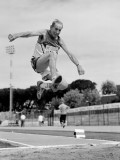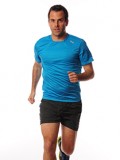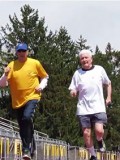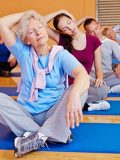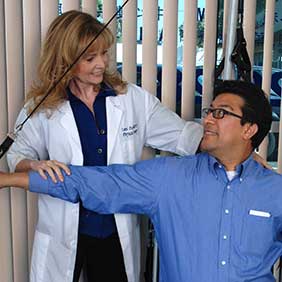
Tami Peavy, Physical Therapist, Practical Therapy4U, instructs client in techniques to relieve back pain. Photo: Angels Touch, Inc.
by Tami Peavy, MPT Physical Therapist
New entrepreneurs seem to get better with age. In fact, founders of startup companies by people over 50 is more than double those 25 years old, according to a survey by the Kauffman Foundation. But with that trend comes many long hours behind a desk looking at a computer or down at a cell phone.
It’s easy to get caught up in the drive to create your own business and forget to put the same attention to your body. The consequences of these long hours of sitting take its toll not only on your body, but your brain as well.
Brain stimulated by movement
Neuroscience research has shown that 90% of your brain’s stimulation and nutrition comes from spinal movement. That is why after hours of sitting in your office chair, you begin to feel tired and the ”brain fog” sets in. It becomes difficult to concentrate and your eyelids feel heavy. Your brain needs the circulation that comes from moving your body. That movement feeds your brain’s creativity.
Computer aches and pains
Long hours in front of the computer cause aches and pains in the back and promote poor posture. Prolonged sitting creates weakness in the key muscles that are needed to keep a strong back and a healthy posture.
Most everyone will experience back pain at least once during their lives. But for many people, it is not just once, but multiple times over a lifetime.
Physical therapy can help
Back pain is the most common reason people go to physical therapy. While there are many remedies that claim to cure back pain, few are permanent solutions. This is because most advertised remedies are passive solutions like a shot, a pill or back brace; rather than an active treatment that corrects the problem long-term.
Taking an active role in finding relief from back pain and preventing it from returning, means strengthening the most important muscle in your body for balance and alignment: your gluteus maximus (also known as glutes).
The glutes are the largest muscles in your body. They connect the top of your body to the lower part and hold it in an upright position. When your back begins to hurt, it is a signal telling you that you have weakness in your glutes. Your lower back muscles are straining to do the job of your glutes, hold you upright and strong. Your glutes create overall muscle balance in your body to give your body support and proper alignment.
Believe it or not, your glutes will determine how well you will age. It is the muscle that holds the key to your balance, your posture and freedom from back pain and sciatica.
Traditional therapy and personal training is based on the idea that doing squats is the best way to strengthen your glutes, but that exercise is really so wrong for anyone over the age of 30 because it puts strain on the lower back and knees and actually weakens the glutes long-term.
The exercises that worked for us when we were in our 30s can turn out to be detrimental to our bodies after age 45. The most effective, long lasting therapy for better backs is to learn movement patterns that you use throughout the day. Gravity is doing its job of pulling us forward and we must counteract that force with strong muscles and posture with specific movement patterns.
In the meantime, use these three important tips to create a better desk and office environment and fight that gravitational pull into a painful posture:
Position your computer display correctly
Elevate your computer display so that the bottom of the screen is level with your chin when you hold your head up in a neutral position. Use risers, or books or anything you can find to bring your viewing angle up.
Therapy ball
Consider using a therapy ball at your desk instead of a chair at least 50% of the time. This creates a mobile sitting platform that makes you use your postural muscles. It also means more spinal movement to stimulate that much needed circulation to your brain.
Stand up and stretch
Set an alarm that reminds you to stand up and reach your arms behind your back. Clasping your hands together behind your back will stretch out your tight pectorals or chest muscles that are pulling your shoulders forward.
Your back craves movement to feed your body and brain. It’s one craving you can give into without any guilt!
Physical Therapist Tami Peavy is the founder of PracticalTherapy4U, producing therapeutic exercise programs like the “Better Back” video on DVD and downloads.



